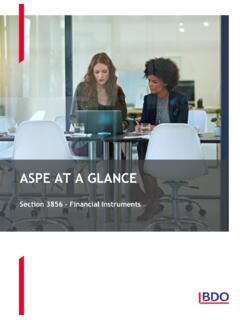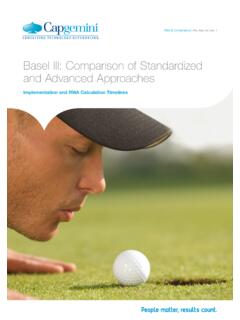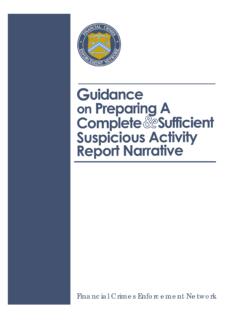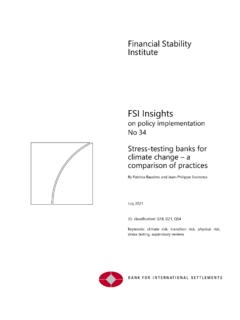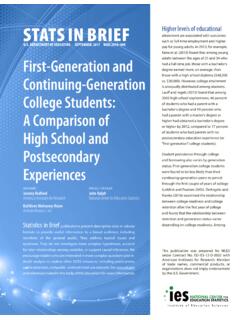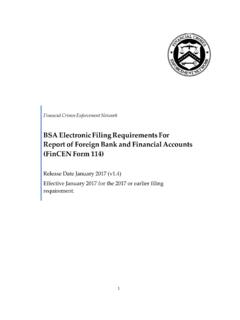Transcription of ASPE - IFRS: A Comparison - BDO Canada
1 ASSURANCE AND ACCOUNTING ASPE - ifrs : A Comparison financial Statement Presentation In this publication we will examine the key differences between Accounting Standards for Private Enterprises (ASPE) and International financial Reporting Standards ( ifrs ) related to financial statement presentation with a focus on the classification and presentation differences on the financial statements. References aspe ifrs Section 1505 Disclosure of accounting policies Section 1506 Accounting changes Section 1510 Current Assets and Current Liabilities Section 1520 Income Statement Section1521 Balance Sheet Section 1540 Cash Flow Statements Section 3251 Equity IAS 1 Presentation of financial Statements IAS 7 Statement of Cash Flows IAS 8 Accounting Policies.
2 Changes in Accounting Estimates and Errors Overview of Major Differences While the requirements of financial statement structure and content are more prescribed under ifrs than ASPE, fundamentally both frameworks have the same requirements for financial statement presentation. A complete set of financial statements include a Statement of financial Position, Statement of Comprehensive Income ( ifrs ) and Income Statement (ASPE), Statement of Changes in Equity, Statement of Cash Flows and appropriate note disclosure. While the naming conventions under ifrs are different than ASPE, an entity may use titles for the statements other than those used in IAS 1.
3 There are some major differences in the requirements such as: Under ifrs , on the Statement of financial Position, only conditions that exist at the year-end date are considered when classifying demand loans or loans with covenant violations. Therefore, waivers for violations must be obtained before the reporting date to be classified as non-current. IAS 1 requires the presentation of a third Statement of financial Position in certain situations. ASPE - ifrs : A Comparison | financial Statement Presentation 2 ifrs has the concept of other comprehensive income which comprises of items of income and expense, including reclassification adjustments that are not recognized in profit or loss as required or permitted by specific IFRSs.
4 These include: changes in revaluation surplus (IAS 16, IAS 38), actuarial gains and losses on defined benefit plans (IAS 19), gains and losses arising from translating the financial statements of a foreign operation (IAS 21), gains and losses on remeasuring available-for-sale / fair value through OCI financial assets (IAS 39/ ifrs 9) and the effective portion of gains and losses on hedging instruments in a cash flow and net investment hedges (IAS 39/ ifrs 9). financial Position The presentation requirements of the Statement of financial Position under ASPE and ifrs are very similar.
5 The key difference is that there is a requirement to present a third Statement of financial Position in certain circumstances under ifrs . Also, under ifrs , only conditions that exist at the year-end date are considered for classification. aspe ifrs The balance sheet distinguishes between current and non-current assets and liabilities. Liquidity based presentation is also permitted in specialized industries but is not a common practice. IAS 1 allows for a classified, current and non-current statement of financial position, as well as a liquidity based presentation when it provides more reliable and more relevant information to the users.
6 Liquidity based presentation is commonly used for financial institutions . The minimum content requirements are similar between both frameworks. Many of the differences that exist relate to differences that exist in the recognition and measurement standards. For a complete list of minimum content requirements under ASPE, please see ASPE at a Glance: financial Statement Presentation. The minimum content requirements are similar between both frameworks. Many of the differences that exist relate to differences that exist in the recognition and measurement standards.
7 For a complete list of minimum content requirements under ifrs , please see ifrs at a Glance: IAS 1 Presentation of financial Statements. Events subsequent to year-end may be considered when determining the classification of demand loans or loans with covenant violations. This results in more loans being classified as long term compared to ifrs . For example, if a waiver is obtained after the balance sheet date for a covenant violation but the waiver refers to conditions at the balance sheet date, the loan can be classified as long-term.
8 Only conditions that exist at the year-end date are considered when classifying demand loans or loans with covenant violations. This would result in more loans being classified as current. For example, if a waiver is obtained after the balance sheet date for a covenant violation but the waiver refers to conditions at the balance sheet date, the loan would be classified as current because the waiver was obtained after year-end. There are no requirements to present a third balance sheet, other than on the initial adoption of ASPE.
9 IAS 1 requires an entity to present a statement of financial position as at the beginning of the earliest comparative period when an entity applies an accounting policy retrospectively or makes a retrospective restatement of items in its financial statements, or when it reclassifies items in its financial statements. This would result in three statements of financial position being presented for reclassifications and restatements. This is also required in the year of initial adoption of a new accounting standard that requires retrospective application.
10 ASPE - ifrs : A Comparison | financial Statement Presentation 3 Other than disclosure of certain specific information, related notes are not required to accompany the opening statement of financial position as at the beginning of the preceding period. Changes in Equity The presentation requirements related to changes in equity under ASPE and ifrs are very similar. The key difference that arises is that ifrs requires a reconciliation on the face of the financial statements. aspe ifrs An entity is required to present separately changes in equity for the period arising from each of the following: Net income showing separately the total amounts attributable to owners of the parent and to non-controlling interests; Other changes in retained earnings; Changes in contributed surplus; Changes in share capital; Changes in reserves; and Other changes in equity Also, an enterprise should present separately the following components of equity: Retained earnings; Contributed surplus.
